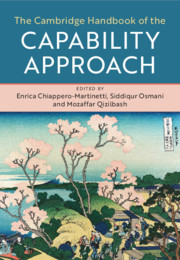Book contents
- The Cambridge Handbook of the Capability Approach
- The Cambridge Handbook of the Capability Approach
- Copyright page
- Dedication
- Contents
- Figures
- Tables
- Contributors
- Foreword
- Acknowledgements
- General Introduction
- Part I Historical Antecedents and Philosophical Debates
- Part II Methods, Measurement and Empirical Evidence
- Introduction to Part II
- 13 Social Choice and the Capability Approach
- 14 On Capability and its Measurement
- 15 Analyzing Capabilities
- 16 Implementing the Capability Approach with Respect for Individual Valuations
- 17 Capability, Opportunity, Outcome and Equality
- 18 The Distribution of Capabilities
- 19 Inter-Group Disparities in the Distribution of Human Development
- 20 Multidimensional Inequality and Human Development
- 21 The Research Agenda on Multidimensional Poverty Measurement
- 22 Measuring Gender Inequality Using the Capability Approach
- 23 Econometric and Statistical Models for Operationalizing the Capability Approach
- 24 Expanding Capabilities through Participatory Action Research
- Part III Issues in Public Policy
- Index
- References
18 - The Distribution of Capabilities
Up, Down, Sideways and Along
from Part II - Methods, Measurement and Empirical Evidence
Published online by Cambridge University Press: 11 November 2020
- The Cambridge Handbook of the Capability Approach
- The Cambridge Handbook of the Capability Approach
- Copyright page
- Dedication
- Contents
- Figures
- Tables
- Contributors
- Foreword
- Acknowledgements
- General Introduction
- Part I Historical Antecedents and Philosophical Debates
- Part II Methods, Measurement and Empirical Evidence
- Introduction to Part II
- 13 Social Choice and the Capability Approach
- 14 On Capability and its Measurement
- 15 Analyzing Capabilities
- 16 Implementing the Capability Approach with Respect for Individual Valuations
- 17 Capability, Opportunity, Outcome and Equality
- 18 The Distribution of Capabilities
- 19 Inter-Group Disparities in the Distribution of Human Development
- 20 Multidimensional Inequality and Human Development
- 21 The Research Agenda on Multidimensional Poverty Measurement
- 22 Measuring Gender Inequality Using the Capability Approach
- 23 Econometric and Statistical Models for Operationalizing the Capability Approach
- 24 Expanding Capabilities through Participatory Action Research
- Part III Issues in Public Policy
- Index
- References
Summary
This chapter explores what inequality looks like from the perspective of the capability approach. ‘Sideways’ inequality — that is, inequality between individuals and groups in their risk of experiencing disadvantage — has been central to the capability approach since its inception, and we have tools such as the Equality Measurement Framework with which to systematically assess multidimensional horizontal inequalities. This includes examining differences in outcomes, in how people are treated, and in the autonomy they enjoy. ‘Up and down’ inequality — that is, how people are distributed across the spectrum between advantage and disadvantage, has been much less thoroughly investigated within the capability approach, and there are normative, conceptual and empirical issues to be resolved. In comparison to an exclusive focus on income and other economic resources, analysis of multidimensional vertical inequality is likely to alter who is understood to be most advantaged, how much advantage they have (the degree of stretch), and the extent of concentration of advantage in the distribution as a whole. Finally, inequality ‘along’ the dimension of time has become an important component of research on income inequality, and there are analogous questions about both short- and long-run capability mobility that we are only just beginning to address.
- Type
- Chapter
- Information
- The Cambridge Handbook of the Capability Approach , pp. 347 - 369Publisher: Cambridge University PressPrint publication year: 2020

